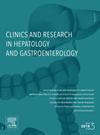Co-exposure to different bacterial species’ lipopolysaccharides with the NASH diet exacerbates NASH and liver fibrosis progression in mice
IF 2.6
4区 医学
Q2 GASTROENTEROLOGY & HEPATOLOGY
Clinics and research in hepatology and gastroenterology
Pub Date : 2024-09-22
DOI:10.1016/j.clinre.2024.102470
引用次数: 0
Abstract
Background and aim
With the obesity epidemic, nonalcoholic fatty liver disease (NAFLD) has become a public health concern, but its progression mechanism remains unclear. Experimental models mimicking human NAFLD/steatohepatitis (NASH) are crucial. This study simulates gut microbiota imbalance effects on NASH and liver fibrosis.
Methods
We used different bacterial sources of lipopolysaccharide (LPS), including Escherichia coli (GEC) and Salmonella abortus equi (GSE), combined with a Gubra Amylin NASH (GAN) diet to induce NASH and liver fibrosis.
Results
The GSE group showed significantly higher serum alanine aminotransferase, hydroxyproline, CD68-positive cells, α-smooth muscle actin, glial fibrillary acidic protein, and TNF-α, COL1A1, TGF-β, and NLRP3 expressions compared to the the GAN group. The GSE group also had higher Erysipelotrichaceae, Akkermansiaceae, and Bacteroidaceae family numbers.
Conclusions
The GAN diet with LPS treatment successfully induced NASH and fibrosis making this model useful for preclinical NASH drug testing.
不同菌种的脂多糖与 NASH 饮食共同暴露会加剧小鼠的 NASH 和肝纤维化进程。
背景和目的:鉴于肥胖症的流行,非酒精性脂肪肝已成为公共卫生问题;然而,其发展机制仍不清楚。因此,有必要建立能反映人类疾病的实验性非酒精性脂肪肝/脂肪性肝炎(NASH)动物模型。在这项研究中,我们模拟了肠道微生物群失衡对 NASH 和肝纤维化的影响:不同细菌来源的脂多糖,包括大肠杆菌(GEC)和流产马沙门氏菌(GSE),与古布拉淀粉酶NASH(GAN)饮食相结合,诱导NASH和肝纤维化:结果:与GAN组相比,GSE组肝脏中血清丙氨酸氨基转移酶、羟脯氨酸、CD68阳性细胞、α-平滑肌肌动蛋白、胶质纤维酸性蛋白的水平以及TNF-α、COL1A1、TGF-β和NLRP3的表达均明显升高。经脂多糖(LPS)处理的 GAN 饮食导致微生物群 α 多样性的显著差异。与其他组相比,GSE 组 Erysipelotrichaceae、Akkermansiaceae 和 Bacteroidaceae 的数量增加较多:基于这些结果,GAN 饮食结合 LPS 治疗成功地诱导了肝病向 NASH 和纤维化的进展。这种肥胖 NASH 小鼠模型具有一致的组织学证实的纤维化,具有相对较好的临床转化性,非常适合用于 NASH 的临床前药物测试。
本文章由计算机程序翻译,如有差异,请以英文原文为准。
求助全文
约1分钟内获得全文
求助全文
来源期刊

Clinics and research in hepatology and gastroenterology
GASTROENTEROLOGY & HEPATOLOGY-
CiteScore
4.30
自引率
3.70%
发文量
198
审稿时长
42 days
期刊介绍:
Clinics and Research in Hepatology and Gastroenterology publishes high-quality original research papers in the field of hepatology and gastroenterology. The editors put the accent on rapid communication of new research and clinical developments and so called "hot topic" issues. Following a clear Editorial line, besides original articles and case reports, each issue features editorials, commentaries and reviews. The journal encourages research and discussion between all those involved in the specialty on an international level. All articles are peer reviewed by international experts, the articles in press are online and indexed in the international databases (Current Contents, Pubmed, Scopus, Science Direct).
Clinics and Research in Hepatology and Gastroenterology is a subscription journal (with optional open access), which allows you to publish your research without any cost to you (unless you proactively chose the open access option). Your article will be available to all researchers around the globe whose institution has a subscription to the journal.
 求助内容:
求助内容: 应助结果提醒方式:
应助结果提醒方式:


